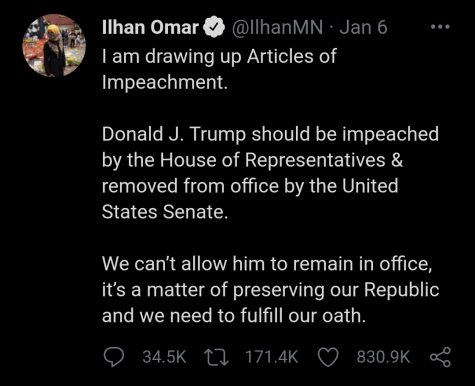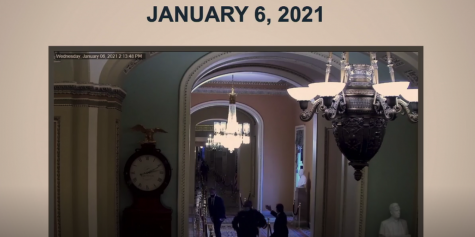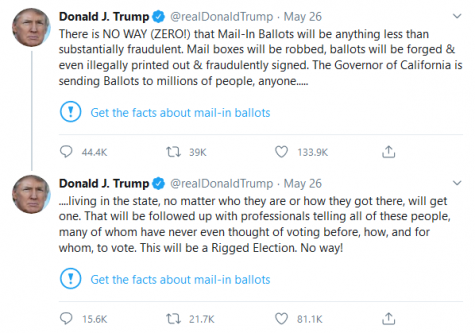Trump Impeachment Trial Recap
Donald J. Trump was impeached for the second time on January 13th. His Senate trial to convict followed soon after.
Representative Alexandria Ocasio-Cortez calls for Trump’s impeachment following the attempted coup.
Former president Donald J. Trump is the first president to be impeached twice and the first ex-president to undergo an impeachment trial.
Representatives Jamie Raskin (MD), David Cicilline (RI) and Ted Lieu (CA) drafted an article of impeachment that charged Trump with “incitement of insurrection.” The impeachment vote succeeded on January 13th and was followed by the Senate trial to convict, which began on Tuesday, February 9th.

What is impeachment?
Article II, Section 4 of the Constitution states: “The President, Vice President and all civil Officers of the United States, shall be removed from Office on Impeachment for, and Conviction of, Treason, Bribery, or other high Crimes and Misdemeanors.”
Impeachment itself is not the removal of federal government officials, but it is the vote to charge them for crimes or misdemeanors.
Congresspeople from the House of Representatives bring forth (an) article(s) of impeachment that clearly and thoroughly state the crimes or misdemeanors the political figure allegedly committed.
The House then votes to approve the article(s) by majority vote. If it/they succeed(s), the federal official is officially impeached and the articles move to the Senate. The Senate then must vote by a ⅔ majority to convict the official. Conviction results in removal from office and sometimes a disqualification from running for any office in the future.
Who was at the impeachment trial?
Impeachment team:
Speaker Nancy Pelosi named nine Democratic representatives and delegates as team managers, with Rep. Jamie Raskin of Maryland as the leader; the rest of the team consisted of Rep. David Cicilline (RI), Rep. Ted Lieu (CA), Rep. Diana Degette (CO), Rep. Joaquin Castro (TX), Rep. Eric Swalwell (CA), Rep. Joe Neguse (CO), Rep. Madeleine Deane (PA), and Delegate Stacey Plaskett (Virgin Islands).
Trump legal defense counsel:
Donald Trump was represented by four lawyers:
Bruce Castor and David Schoen acted as defense attorneys and were joined by Michael Van der Veen and William Brennan for the presentation.
What happened during Trump’s second impeachment trial?
Day 1 Recap – Tuesday, Feb. 9th:
The Senate laid out a resolution:
- There will be four hours of debate regarding the constitutionality of the trial, after which a vote will take place. The majority of votes decide if this trial is constitutional, therefore determining if the trial continues.
- After the vote, each side (the impeachment team and the defendants) have 16 hours for the presentation to exhibit their case.
- Then there will be another four hours for questions from the Senators regarding the presentation, arguments, and any evidence that may be brought forth.
- If so requested by the impeachment committee or defendants, there will be another two hour debate and a vote to call in witnesses.
- This will be followed by four hours of closing arguments from each side, evenly divided (allowing for two hours of each side).
- The Senate will then vote on the conviction or acquittal of Donald J. Trump will take place.
Step one succeeded, with the House impeachment team leader Rep. Jamie Raskin of Maryland beginning his team’s argument with a 13 minute video showcasing the Capitol attack and what they believed to be Trump’s incitement. Please take note that this video is graphic and may disturb some watchers. Raskin also followed up with a personal account of the attack, at one point recalling the moment that he thought his family, who was there that day, was “going to die.”
As a counter, Bruce Castor, acting as a defense attorney for Trump, complimented the Democrat’s performance, stating they were “brilliant speakers.” Castor then declared that the majority of the House of Representatives “doesn’t want Donald Trump as a political rival” and that they needed an impeachment conviction to accomplish his removal. Trump’s second lawyer, David Schoen, expressed frustration with Raskin’s video – stating that it looked like the impeachment team hired a “movie company” to edit it and show the most gruesome segments of the attack recordings.
Trump’s defense argued that the impeachment trial, should it proceed, was unconstitutional, as Trump was already out of office.
However, their efforts failed, as the Senate voted 56-44 for the trial to proceed.
Day 2 Recap – Wednesday, Feb. 10th:
House impeachment managers presented unseen new footage from the Capitol attack on Wednesday. The clips showed how close the rioters, many with intention to kill, kidnap, or maim, got to the Senators and Representatives.
- These clips, while similar to the video showing the initial attack and Trump’s incitement of it, demonstrated how much more dangerous this event could have been.
- Throughout their arguments, the impeachment managers set the timeline of Trump’s incitement, beginning months prior. They established that Trump encouraged violence at not only the rally before the attack, where Rudy Giuliani declared to “have trial by combat” and Trump encouraged his supporters to “fight like hell,” but throughout months of conspiracy theories and doubts about the election and its security.
- Raskin stated that instead of commander in chief, Trump became “inciter in chief” who allowed and encouraged rioters to bring “hell on [them] that day.”
- Stacey Plaskett presented the Capitol images to demonstrate how close the rioters managed to get to the Senators and Representatives. She also presented images and video of the rioters smashing windows and doors near the Senate Chamber along with police audio declaring the scene a riot and calling for aid. Plaskett stressed the importance of the new information of how close attackers got to federal officials, as many were there in efforts to execute Vice President Mike Pence for ‘betraying’ them by confirming the electoral college results or to kill Speaker Pelosi.
- After the impeachment team presented the graphic imagery of the attack, Representative Castro further exemplified Trump’s role in the insurrection, saying that Trump, instead of condemning the rioters and sending them home, strengthened the rioters’ will to disrupt the process and maim those involved.

Day 3 Recap – Thursday, Feb. 11th
Day 3 of the impeachment trial consisted of the impeachment team finalizing their arguments and conclusively proving Trump’s incitement and links to the Capitol insurrection.
- Representative Degette presented additional imagery and video from the attack and from messages on social media sites prior to the attack that demonstrated Trump’s role in inciting the insurrection. Videos showed rioters directly stating they believed Trump had invited them there: “Our president wants us here. We wait and take orders from the president.” “There’s a…million of us out there, and we’re listening to Trump, your boss.” “Does [Biden] not realize Trump called us to siege the place?”
- Representative Raskin presented other video years prior to the attack where Trump incited and defended the violence of his supporter base, where at multiple rallies, his supporters assaulted counter-protesters. Before he presented the video, he stated, “…but no matter how many people inside and outside the government begged him to condemn extreme elements, promoting violence, and indeed civil war in America and race war in America, he just wouldn’t do it. And that’s because he wanted to incite and provoke their violence for his own political gain and for his own strategic objectives. Ever since he became president, Trump revealed what he thought of political violence – for his side, he praised it and he encouraged it.”
- Representative Lieu not only emphasized Trump’s tweeted video where he told the rioters he loved them, he listed numerous ex-Trump officials who publicly drew correlation between Trump’s violent rhetoric and the Capitol attack.

- Representative Cicilline provided insight on other representatives and senators’ accounts from the attack, where they created extra forms of barricades and obstacles, hid, attempted to become less conspicuous by removing any sort of government attire, and even reached out to loved ones to say their potential goodbyes.
- Impeachment management team leader Jamie Raskin rested the team’s case, encouraging Republicans to vote with “common sense,” and wished them luck in their debates and deliberations.
Day 4 Recap – Friday, February 12th
Day 4 of the impeachment trial marked the first day of Trump’s defense team’s official arguments against conviction.
- Michael Van der Veen began the argument by stating that “no thinking person” could blame Trump for the insurrection or claim he incited it. He also declared the trial “unconstitutional” and a “witch hunt,” which was used to describe Trump’s first impeachment. Van der Veen provided evidence that several members of Congress objected to Trump’s electoral victory in 2016, stating that “to litigate questions of election integrity within the system is not incitement to insurrection. It is the democratic system working as founders…have designed.” He also stated Trump’s comments were “ordinary political rhetoric.”
- Lawyer David Schoen believed that the impeachment managers “manipulated video” and relied on media reports for evidence; however, the legal team denied the request to have Trump appear in court under oath.
- Schoen then presented a video montage of Democratic leaders using the word “fight” in an attempt to prove hypocrisy within the Democratic party for accusing Trump of violent rhetoric when they used the same language, despite the fact none of those speeches resulted in an attempted coup.
- Bruce Castor stated there is no need for conviction due to ‘incitement of insurrection’ because “there was no insurrection.”
- Trump’s defense team rested their case, allowing for an extra 2 ½ hours for questions from senators.
Day 5 Recap – Saturday, Feb. 13th
- After a vote from the Senate, Donald Trump was acquitted.
- The Senate vote was the most bipartisan impeachment conviction vote in American history and was the first time since 1868 that the majority of the Senate voted to convict.
- It failed on a 57-43 vote, 10 less than the needed ⅔ majority.
- Out of 50 Republicans, 7 voted to convict. All Democratic senators also voted to convict.
- After the acquittal, House impeachment managers and Trump’s legal team presented their closing arguments, and the trial ended.
- Jamie Raskin congratulated Democratic efforts to impeach and convict the president. “[Trump and the rioters] tried to trash our democracy and we revived it, and we protected,” he stated.
- Senate Majority Leader Chuck Schumer stated after the vote, “Let the record show — before God, history and the solemn oath that we swear to the Constitution — that there was only one correct verdict in this trial: guilty.”



